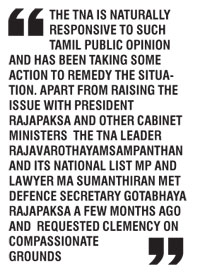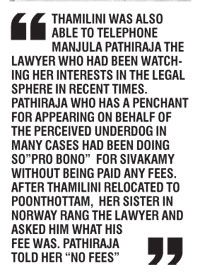06 Jul 2012 - {{hitsCtrl.values.hits}}
 (CONTINUED FROM LAST WEEK)
(CONTINUED FROM LAST WEEK) The meeting between Mother and daughter was quite emotional with Sivakamy repeatedly crying “Manniyungo” (forgive me).Earlier when informed over the phone that the daughter was going to be rehabilitated the mother had been speechless and had simply sobbed into the receiver. When Thamiliniwas asked what her future plan was after rehabilitation, she had just said”nothing except to go and be with my mother”.
The meeting between Mother and daughter was quite emotional with Sivakamy repeatedly crying “Manniyungo” (forgive me).Earlier when informed over the phone that the daughter was going to be rehabilitated the mother had been speechless and had simply sobbed into the receiver. When Thamiliniwas asked what her future plan was after rehabilitation, she had just said”nothing except to go and be with my mother”..jpg)
 Thamilini was able to secure temporary rehabilitation as opposed to permanent incarceration due to a favourable combination of circumstances. Three separate courses of events converged to some extent in her case. This proved beneficial to her.Her rehabilitation based release is also a harbinger of hope for others of her ilk in similar circumstances.
Thamilini was able to secure temporary rehabilitation as opposed to permanent incarceration due to a favourable combination of circumstances. Three separate courses of events converged to some extent in her case. This proved beneficial to her.Her rehabilitation based release is also a harbinger of hope for others of her ilk in similar circumstances..jpg)
.jpg) If the public course of events in the legal sphere and the semi-public course of events in the political sphere were crucial in the transfer of Thamilini from Welikada to Vavuniya for rehabilitation,there was also a third not-so public course of events that played a decisive role in the process. Arguably it was this course of events that ultimately paved the way for a positive decision to be taken in this regard.
If the public course of events in the legal sphere and the semi-public course of events in the political sphere were crucial in the transfer of Thamilini from Welikada to Vavuniya for rehabilitation,there was also a third not-so public course of events that played a decisive role in the process. Arguably it was this course of events that ultimately paved the way for a positive decision to be taken in this regard.
17 Nov 2024 10 minute ago
17 Nov 2024 39 minute ago
17 Nov 2024 4 hours ago
16 Nov 2024 9 hours ago
16 Nov 2024 9 hours ago